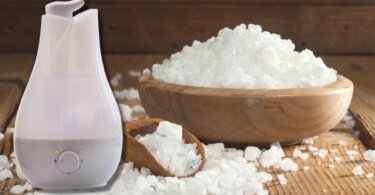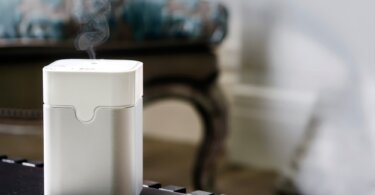Picture this: you enter your home on a scorching day and instantly feel the pleasant indoor air hitting your senses. This air is not directly coming from your air conditioner. Instead, the whole place is feeling cool. That’s the impact a dehumidifier can have in your home if you smartly use it.
Now, this doesn’t mean a dehumidifier can always cool a room and replace an air conditioning unit because that’s hardly the case. In fact, dehumidifiers have a totally different impact on your indoor air, and you cannot use them interchangeably.
To answer the question: No, a dehumidifier cannot cool the room temperature room but it can feel cooler because it lowers the humidity levels in the room. If you want to clear this confusion and use your dehumidifier the right way, stick around and let us explain.

Why Does a Room Feel Cooler When The Dehumidifier Is On?
A dehumidifier absorbs the excess moisture from a room, leaving it with a comfortable environment and lower humidity levels. Since the ideal level of humidity of indoor air is between 40-60%, people in humid climates use dehumidifiers to control the extra moisture.
When a dehumidifier soaks the excessive moisture, the indoor air feels lighter, more pleasant, and sometimes odor-free. These changes can make you think a dehumidifier can cool a room, but in terms of numbers, that’s not true.
You feel these pleasant changes because the air you’re inhaling is lighter, and the humidity levels are ideal – it doesn’t have much to do with the temperature.
The changes in a room’s relative humidity can foster the idea that a dehumidifier can reduce the temperature levels around it.
But if you check the room’s temperature with a thermometer, you’re likely to notice a slight temperature hike because of the dehumidifier.
How Does a Dehumidifier Impact Your Body’s Temperature Regulation Mechanism?
Dehumidifiers alter our breathing air, temperature, and overall comfort – you better get a great dehumidifier.
If you’re using a dehumidifier for a while, you might notice some changes in your skin and overall body moisture levels because temperature dehumidifiers suck some moisture out of your skin.
Say the weather in your home is mostly humid and heavy. This weather increases your body temperature levels and asks for some heat regulation.
But thanks to the heavy, moist indoor air that already contains plenty of water, the excess moisture in your body cannot evaporate well.
As a result, you feel uncomfortable and sometimes suffocated because even when the AC and fan are on, you still feel hot.
That’s when a dehumidifier enters the scene to reverse this problem. Smart house dehumidifiers bring the indoor air’s humidity levels between 40-60%, ensuring you feel comfortable and light.
When you leave the dehumidifier on for a few hours each day, your skin doesn’t undergo extreme temperature or moisture changes, and you breathe more comfortably.
Dehumidifiers are energy-efficient electric appliances working round the clock to improve your life quality and breathing air. Whether you have allergies or the summer months are extra humid in your region, a dehumidifier can be a great friend.

How Can You Use Your Dehumidifier To Cool a Room?
Here comes a twist: if you use your dehumidifier the right way, it can make your room feel significantly cooler despite no apparent change in the temperature. Sounds interesting, right?
If you want to avail this benefit from your dehumidifier, here’s what you can do:
- Getting a capable dehumidifier is your first task. Since standard dehumidifiers have a short work range and running them for too long can exhaust their filters, you’ll need an energy-efficient dehumidifier. Central and basement dehumidifiers have powerful filters and coils to cover the entire room, ensuring you inhale lighter air.
- Choosing an optimal place for your particular type of dehumidifier is the next step. If you leave your dehumidifier by the window or in a corner, it might not absorb the extra moisture the way it should. Therefore, you should prefer a central dehumidifier with impressive absorbing capacity for your place. This dehumidifier will ensure the outdoor air doesn’t mess with your home’s temperature and keeps things cool and pleasant.
- If the outdoor air has free excess to a room where the dehumidifier is working, you won’t feel any difference in the temperature. Make sure your room is thoroughly insulated, and the indoor air gets dehumidified pretty fast.
- Leaving the dehumidifier on for a long period (3-4 hours) ensures your breathing air is free of the musty smell, extra moisture, and the general heaviness that comes with humidity. Turn on your dehumidifier an hour in advance to enjoy a comfortable sitting in the living room or bedroom.
- If your dehumidifier’s water tank is full, it will have trouble absorbing the excess moisture. Consequently, you’ll have to inhale humid and heavy air that can impact your body’s temperature regulation mechanism. You should either turn on the dehumidifier’s auto-draining option or empty its water can before its starts to overflow.
- Keep your dehumidifier’s foils and filters clean to ensure they work fine. Besides positively impacting the dehumidifier’s absorbing capacity, this cleaning practice also controls airborne allergens and pollutants.
How Does a Dehumidifier Affect Your Air Conditioning Unit?
It’s a common misconception that dehumidifiers can replace ACs in the long run, which is a baseless claim. An air conditioner removes hot air from a room and replaces it with colder outside air, eventually decreasing the room’s temperature.
On the flip side, a dehumidifier simply absorbs the moisture from indoor air and drains that water out to make the air feel lighter. So, these two appliances are never interchangeable.
But if you run your dehumidifier before the AC, it can bring a good change along. Since cooling and rotating heavy air can make the air conditioner work extra hard, it results in extra energy costs and lower cooling levels.
If you have a dehumidifier to assist this task, you’ll feel a faster and more comfortable cooling sensation in the room. The AC will cool the incoming air and the dehumidifier will remove extra water molecules from it, ensuring you’re always comfortable.
If you live in a very humid and hot region, using these two smart appliances one by one will be in your best interest. The dehumidifier won’t make your respiratory system work extra hard, and the AC will cool things down.
Summing Up
Smart electronic appliances like dehumidifiers make our lives more comfortable and hassle-free.
Whether you live in a humid region or processing moist air always goes hard on your respiratory system, you need a good dehumidifier at home. This appliance will maintain optimum moisture levels in your indoor air and prevent some allergic reactions.
However, don’t confuse the dehumidifier with a cooling appliance. A dehumidifier cannot cool the room, it is designed to make your breathing air comfortably dry.
We hope your confusion about dehumidifiers and their cooling capacity is over now, and you’ll invest smartly!
Related article: Do I Need a Dehumidifier in Every Room?





Leave a Comment